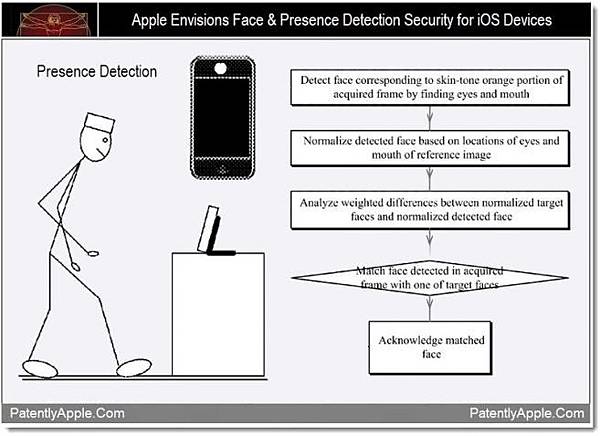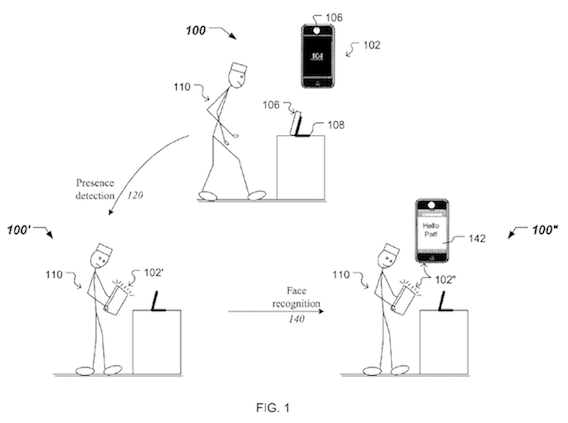

很像有點爭議面對谷歌的銀河的Nexus智能手機內置的解鎖功能,一個新的專利申請表明蘋果太上相似,但更高級的用戶檢測解決方案的工作,作為 PatentlyApple指出,蘋果指出這些識別系統可能陷入未來的iPhone,iPad,iPod的觸摸,或MacBook。
專利的基本知識題為“低門檻臉部識別”,就是允許用戶解鎖設備,這樣的iPhone或iPad,使用面部識別,蘋果的解決方案可以使設備的攝像頭識別用戶即使設備在睡眠模式,換言之,該設備的攝像頭將保持活躍睡覺時,發現該用戶,解鎖,而不必按睡眠/喚醒按鈕的設備,這可能在理論上,允許用戶繞過目前的滑動解鎖功能。
也許系統最有趣的方面是對設備的設置能力進行定制取決於用戶,例如,當檢測到一個特定的用戶,IOS可以設置個性化壁紙,通知設置,並應用自定義配置,這會提供多個用戶登錄,讓 iOS用戶方便地共享家人或同事之間的設備。
蘋果的系統將不同於其他臉部識別系統忽略的臉生物識別技術作為 PatentlyApple解釋說:“面部識別技術是一個簡單,加權差圖,而不是傳統的(和計算貴)相關匹配的基礎。”蘋果的系統可以檢測“高信息部分“一,如眼,口,或一個鼻尖的臉。此外,”橙距離過濾器“可用於確定在膚色的變化和檢測”可能存在的用戶“這可能與檢測設備和用戶的臉的距離,以及用戶的“注意力水平。”
2010年,在iPad推出之前,華爾街日報報導蘋果有能力識別與設備的攝像頭個人用戶試驗,今天的專利最初是在2009年提交。
十一月,另一個蘋果專利浮出水面詳細敘述了先進的三維物體識別和驗證,可能有潛在的安全系統,一切從地圖實現的方法。
Much like the somewhat controversial face unlock feature built-in to Google’s Galaxy Nexus smartphone, a new patent application reveals Apple too is working on similar, but more advanced user detection solutions. As PatentlyApple pointed out, Apple noted these recognition systems could land in a future iPhone, iPad, iPod touch, or MacBook.
The basics of the patent entitled “Low Threshold Face Recognition,” is to allow a user to unlock a device—such an iPhone or iPad—using facial recognition. Apple’s solution could allow the device’s camera to recognize the user even when the device is in sleep mode. In other words, the device’s camera would remain active when sleeping, detect the user, and unlock the device without having to press the sleep/wake button. This could, in theory, allow a user to bypass the current Slide to Unlock feature.
Perhaps the most interesting aspect of the system would be the ability for the device’s settings to be customized depending on the user. For example, when detecting a specific user, iOS could set personalized wallpapers, notification settings, and custom configurations for apps. This would provide multiple user logins, allowing iOS users to easily share a device among family or coworkers.
Apple’s system would differ from other face recognition systems by ignoring face biometrics. As PatentlyApple explained, “The face recognition techniques are based on a simple, weighted difference map, rather than traditional (and computationally expensive) correlation matching.” Apple’s system could detect “high information portions” of a face such as the eyes, mouth, or the tip of a nose. In addition, an “orange-distance filter” could be applied to determine variations in skin tone and detect the “likely presence” of a user. This could detect the distance between the device and the user’s face, as well as the user’s “level of attentiveness.”
In 2010, before the iPad launch, The Wall Street Journal reported Apple was experimenting with the ability to recognize individual users with the device’s camera. Today’s patent was originally filed in 2009.
In November, another Apple patent surfaced detailing a method of advanced 3D object recognition and verification that could be potentially implemented in everything from security systems to maps.



 留言列表
留言列表